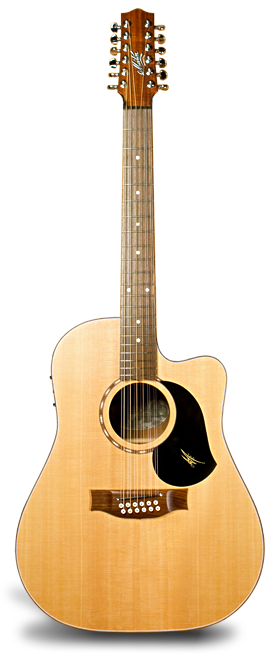
Maton EM425C/12 A popular and solid 12 string Maton guitar, made to last and sound good. Now a good mid-price 12 string option and great value in a studio for those times when you really just need a 12 string guitar. |
GEAR RELATED ARTICLES
[Home Music Recording Studio]
GUITAR AMPLIFIERS:
Acoustic 450 - 170W Guitar / Bass Amp Head
Behringer Ultrabass BXL1800A 180W Bass Amp
Fender Princeton Chorus 51W Compact Amp
GUITARS:
Aspen AD25 6 String Acoustic Guitar
Esteve Model 8 Classical Guitar
La Patrie Concert CW QIT Classical Guitar
La Patrie Presentation Classical Guitar
Fender DG-14SCE Nat Acoustic Guitar
Godin XtSA Electric Guitar
Godin Freeway Classic Electric Guitar
Ibanez RG8 8 String Electric Guitar
Jim Beam Devil's Cut 335 clone
Maton EM125C - 6 String Acoustic Guitar
Maton EM425C/12 12 String Acoustic Guitar
Maton Mastersound MS500 - 6 Str Electric Guitar
Yamaha FG-410-12A 12 String Acoustic
Yamaha G-228 6 String Classical
GUITAR FX - The Chronicles of Zoom:
ZOOM GFX-707 - Review and Description
ZOOM 707 II - Review and Description
ZOOM BFX-708 - Bass Guitar Multi Effects Pedal
ZOOM G9.2tt - Guitar Effects Console
Behringer EM600 Echo Machine Stomp Box
Behringer RV600 Reverb Machine Stomp Box
ROLAND U-220 - Vintage Sound / Synth Module
SN-U110 and SN-MV30-S1 Series PCM Cards
Behringer FBQ1502HD Ultragraph Pro
Behringer Eurorack Pro RX1602 Rackmount Mixer
Capabilities of the CASIO WK-7500 Workstation
Presonus Eris E5 Powered Monitor Speakers
Vonyx (Skytec) SPJ-1000A Active 10" Speaker
[ Advertising ]
The Maton EM425C/12, 12 String Acoustic Guitar was introduced in 1989 and was still in production in 2014 (possibly later). A popular 12 string offering from Maton, that was heralded as being amongst the last of the walnut back and sides guitars to be made by Maton due a shortage of suitable walnut timbers.
I had been looking for an upgrade to my trusty old Yamaha FG-410-12A for some time, but was not really keen on spending up to AUD $3K+ on a new Maton SRS![]() 12 string (or similar), when I don't really use a 12 string all that much. So I began looking into used 12 string guitar availability, in and around the AUD $1.5K mark. Other contenders included Takamine (who have a history of making some lovely 12 string guitars), Cole Clark, Taylor and so on ...
12 string (or similar), when I don't really use a 12 string all that much. So I began looking into used 12 string guitar availability, in and around the AUD $1.5K mark. Other contenders included Takamine (who have a history of making some lovely 12 string guitars), Cole Clark, Taylor and so on ...
The guitar under review (purchased by the first and former owner in 2012) came with a Maton hard case.
The instrument arrived in flawless condition, not a single scratch or mark. I take my hat off the the previous owner for his diligent care and maintenance of this fine instrument. Sadly the action was absolutely horrible. My first inclination was to look for the truss rod nut to see what size Allen key (Hex key) I needed.
Then, when I looked at the strings on the guitar, I immediately guessed they might be contributing to the problem. A set of 013-052 medium gauge strings (what I generally refer to as fencing wire). On a twelve string, that's quite a lot of tension.
Note: It wasn't until later that I discovered these strings actually come fitted as standard!
A few sets of D'Addario EJ41 12-String Phosphor Bronze 009-045 were ordered immediately.
 About Review and Description articles, click to expand
About Review and Description articles, click to expand
Notes:
The guitar under review (2012 vintage) was up for grabs on the bay of 'e' at AUD $1,200 (ONO![]() ) ... and already had three offers. So rather than mess around, I put my money on the table and purchased it at the full asking price, which did include shipping and a slightly damaged Maton hard case (missing bottom latch).
) ... and already had three offers. So rather than mess around, I put my money on the table and purchased it at the full asking price, which did include shipping and a slightly damaged Maton hard case (missing bottom latch).
While encountering a new
Maton EM425C/12, 12 string acoustic guitar is somewhat unlikely these days, I think I came pretty close. Since the EM425C/12 has been superseded by the more expensive SRS series, an older Maton model could be a very good purchase, if like me, you only occasionally use a twelve string.
As it turns out,
with the lighter guage strings I now like this
guitar so much, that I am playing a lot more 12 string than I used to.
Playing the Maton EM425C/12
To say that the Maton EM425C/12 12 string acoustic/electric guitar was challenging to play with even medium gauge strings is being unduly polite. The guitar comes ex-factory with 013-052 ('medium') strings fitted.
I'm just not a brute force kind of guitarist. So this review is based on the Maton EM425C/12 after being restrung with extra light 009-045 strings.
 About String Gauges, click to expand
About String Gauges, click to expand
Nobody sets out to make strings that sound like vibrating crap (except perhaps the Chinese, trust me, I've tried some of their strings ;-) ... However, if you are the curious type, there is a YouTube video you should see, that delves into string gauge tonality. I found it to be quite educational - it's based on electric guitar strings, but I think the fundamentals are generally valid and possibly not what one would expect ;-)
This is another vid I found later using an acoustic instrument, which essentially reveals a similar trend to the previous video. Listening to these on my Eris E5 Studio Monitors - to my ears, the heavier strings are duller, lacking both brightness and definition.
My sincere thanks and compliments to those involved for taking the time to do the subject some justice, without resorting to the often quoted and generally meaningless 'esoteric bullshit' that seems to pervade discussions on string gauge.
Having never encountered a twelve string guitar that was actually easy to play, and only ever coming close after tweaking my old Yamaha's action to the max, even the existence of an extra light gauge (009-045) set of strings for a twelve string was nothing short of a revelation.
However, in this case, while the lighter gauge strings definitely made the EM425C/12 easier to play, there was no significant improvement in the guitar's action.
Closer inspection revealed that the action was actually too high at both the Nut and Saddle - something I honestly had not expected, because that means it left the factory that way. Not at all a good look, Maton.
A few hours later - after - taking the strings partially off, to establish that the socket I needed was 8mm on a 70mm extension. Untangling said strings (I think this is a ritual requirement), then restringing, then applying adjustments, tweaking the the truss rod several times (clockwise and about a quarter of a turn all up) - done! The action is as good as it is going to get, short of a full neck job.
The result - infinitely better, actually a pleasure to play now. With the action where it should be, the lighter strings make a big difference. Even a quick lick or two is no problem now. Chords at the 12th fret are a piece of cake (ok, so the cake is a day or two old).
Worth noting: The cutaway on Maton acoustic guitars, while not dramatic, is actually quite useful. Probably a little less so on a twelve string, where the increased action height (even with adjustments) around the twelfth fret will have most players avoiding that area.
If soloing or chording around the twelfth fret is not your thing, then it's worth considering the (E)M245/12 non-cutaway version, which will have slightly greater loudness and depth of tone by virtue of the extra internal volume.
And lastly, it is interesting to note that there are other references to the action of this Maton 12 string model on the internet, where it has been described as, and I quote, 'a bugger to play'. Which suggests that the action problems I encountered might not be an isolated incident.
Measurements are provided with the Maton EM425C/12 specifications below.
Maton EM425C/12 Sound
With the original well worn (perhaps ancient) set of 013-052 Cleartone strings, there was nothing at all special about the sound. Though it was still brighter than my Yamaha FG-410-12A (the guitar I'm replacing).
With a new set of strings however, this beast sings like an angel ... OK ... you're right, I've never actually heard an angel (though I have had an elegant sufficiency of NDEs - not joking). Back to the point - It sounds really good!
There is an actual harmonic sparkle to the sound with all twelve strings ringing, along with a beautiful clarity. This no doubt results largely from the Sitka Spruce solid top.
I was expecting more depth and bass, for a 'D' sized instrument. The overall general tone is definitely on the brighter end of the spectrum, both electrically and acoustically. Of course a substantial component of this new 'zing' will be the D'Addario strings.
Build Quality / Workmanship / Reliability (7/10)
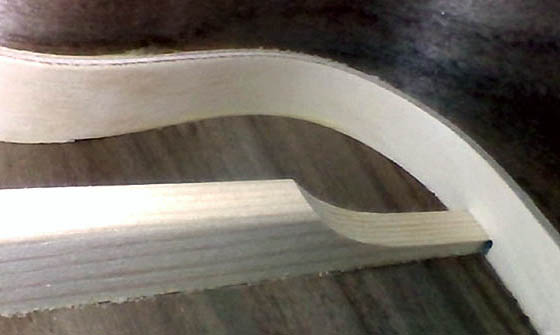
Maton EM425C/12 internal view - Mostly nice and clean, rough in a few places.
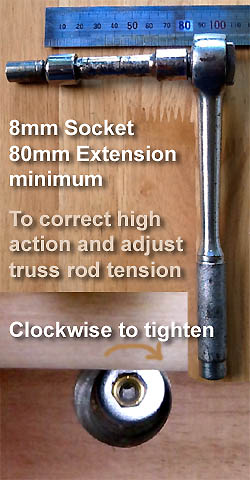 The Maton EM425C/12 under review is a well made 'D' sized instrument, roughly about
years old
The Maton EM425C/12 under review is a well made 'D' sized instrument, roughly about
years old ![]() . The previous owner looked after this guitar and kept it in superb cosmetic condition.
The guitar could have come out of the shop last week.
So reliability (and former owner) get top marks almost by default.
. The previous owner looked after this guitar and kept it in superb cosmetic condition.
The guitar could have come out of the shop last week.
So reliability (and former owner) get top marks almost by default.
Structurally everything on this guitar was 100% functional. An endoscopic inspection (above pic) shows that even the internal workmanship and attention to detail are good (as one should expect from Maton). The frets were beautifully finished, no sharp edges anywhere.
While technically not a fault, I did find the internal geometry and access to the truss rod to be somewhat less than optimal.
It is very difficult to adjust the truss rod in a conventional manner while the EM425C/12 is strung, without using a special Maton truss rod tool. Essentially a shaft that enters through bottom strap pin then extends through the guitar to the neck where the truss rod bolt is located.
Adjusting the Action
on the Maton EM425C/12
It's a normal (not Hex) bolt that requires an 8mm socket, with a 80mm extension (minimum) on a small ratchet. Prying the D and G string sets apart will allow you to get the ratchet into position. A ratchet will allow incremental adjustments (clockwise to tighten / pull back / flatten the neck, viewed from the bridge end) without having to continually reposition the socket.
Warning - do this wrong and you could wreck the neck of the guitar.
Aside from the horrible action, this guitar has few flaws. The high, (almost unusable) action was a real disappointment when I realised it had probably left the factory that way. It can take quite a bit of tweaking to get a six string guitar set up right, so having to properly set up a twelve string instrument was just a total pain in the asp. No $2K instrument should leave the either the factory or shop in that condition.
Active Electronics
I used to think that the AP4 pickup on my Maton EM125C was, well, unimpressive. And that I should have replaced it with an AP5 when I first got that guitar. I'm now glad that I didn't waste my money on such a 'not so little' upgrade.
Why would anyone build active electronics into an acoustic guitar and not include a tuner?
So yes, the AP5 does a job. It is clean, and quiet. The AP5 still uses two AA batteries and therefore still has f-all output, just like the AP4. The mid frequency can however be swept, which is actually a tangible improvement. Apparently the last models in the 400 series did leave the factory with the AP5 Pro electronics.
I couldn't tell you whether that's a meaningful improvement.
Digital Tuner (D'Addario PW-CT-17 Eclipse)
To simplify the tuning process, I purchased a D'Addario PW-CT-17 Eclipse Tuner (AUD $35'ish). Brilliant little piece of kit that will probably remain attached to the headstock of this guitar like a limpit. Something that should never have been required!
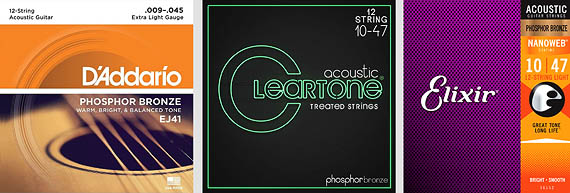
Strings for the Maton EM425C/12
My general personal preference for acoustic guitars that are played regularly, are the light gauge D'Addario EJ41 Phosphor Bronze series strings. Nice and bright but can also deliver a rich tone. They do oxidise fairly quickly (like as soon as you open the packet), but I'm prepared to put up with some dark smudges on my finger tips to get the sound that I want.
Instruments that are played less often, particularly 12 stringed guitars, may benefit from the coated and 'long life' strings available that are made specifically to NOT oxidise. Well not as quickly anyway. Thereby also keeping their tone a little better, for longer. This comes, of course, at generally double the cost of standard string sets.
Be aware that when using coated strings, while your strings may still look all nice and shiny, their tone may be long gone after a year or two under tension on a guitar.
Also -
It can be worth shelling out for a multi-pack purchase, which can bring the unit price of string sets down by anywhere from a third to half.
In this case the 009-045 EJ41 set was chosen in part to take some pressure off the neck - which just FYI, didn't seem to make any difference (which is good, because it indicates there are no truss-rod or neck issues). These will be the lightest strings I have ever run on a twelve string ... so watch this space [ ... ] ... no! I'm just kidding, there's no telling how long it could take me to write more stuff here ![]()
(Only a week or two later) ... So, have you been watching?
It turns out that the finest/thinest string in the 009-042 set is not (as I expected) the pair of .009" high E strings. It is in fact, the .008" +octave G String. As I discovered after concluding that the strings could use a little more stretching, and then over-doing the same ... and breaking it ;-) It broke at the tuning peg and it is unlikely that it would have let go just from normal playing. Another trade-off / downside when using lighter gauge strings.
Just FYI - I'm replacing it with a .009, which I have plenty of, rather than breaking up a 12 string set, just for one string. Now added to my 'list of things to remember ... and not do'.
And just to finish - I now love these strings!!
Value for Money (7/10)
Relatively speaking, the 400 series Maton EM425C/12 was not as expensive as the current SRS series guitars. Though I have not seen it specified officially, the walnut back and sides are suggested to be laminated (plywood in the old lingo), by several reviewers. None the less, Maton's prices appear to have increased rather dramatically in the last few years, possibly due to a move to solid timbers all round. Most 'serious' manufacturers have had to go that way.
I hope that has also translated into a pay rise for the workers at Maton ![]()
While a recent series of upgrades have resulted in several new instrument purchases, on other occasions I have found myself balking at the price of some new instruments, and instead, opting for a well maintained used instrument. That was the case with the EM425C/12. With the Maton SRS-70C-12 seemingly over-priced, a used Maton 12 string was a great option. I would have purchased (and reviewed ;-) a used and slightly more expensive SRS70/12 some months ago, had I been a smidge quicker on the draw.
Production of the Maton EM425C/12 began in 1989 and has now been superseded by the SRS-70C-12 (Solid Road Series). The Maton Museum![]() is somewhat incomplete with respect to details on the Maton EM425C/12, but I have seen used ones for sale with manufacturing dates as late as 2014. There isn't as yet, a clearly specified production 'end date'.
is somewhat incomplete with respect to details on the Maton EM425C/12, but I have seen used ones for sale with manufacturing dates as late as 2014. There isn't as yet, a clearly specified production 'end date'.
As a used instrument, if in good condition, these an are ideal option for the casual 12-stringer. There are other, similar (and sometimes cheaper) offerings from Takamine and Taylor that are also very nice instruments and worth a look. If you need to play a 12 string a lot, you'll probably get yourself an Maton SRS 12 string or perhaps go for broke (literally - you know, mortgage the family home) and get a Martin.
Repairs, Parts, Restoration
Maton should be able to provide most, if not all parts should something need replacing. Which, I have to say, is unlikely unless the instrument has had a disastrous accident. For example, the machine heads are Grover. Whilst they could get banged up and damaged, they are unlikely to fail from normal usage over the life of the instrument.
Probably the biggest hazard is leaving some batteries in too long and having them leak and corrode some electronics. A relatively straight forward replacement job, if you have the skills and tools ... and possibly an opportunity for an upgrade ![]()
Earlier models of the
Maton EM425C/12 had a bone Nut and Saddle, with ABS plastic Bridge Pins. Later models used a Black glass filled Nylon Nut and Saddle with white ABS Bridge Pins. These components should be readily available from the Maton web site or elsewhere online.
Should replacements be required, my personal inclination would be to either go back to a bone Nut and Saddle combo or perhaps try for a Tusq Nut and compensated Graphtech Saddle, if you wanted to go hi-tech (assumes correctly sized parts are available). I have the Graphtech & Tusq combo on a Godin electric and they are top notch.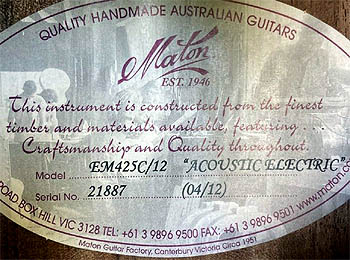
Determining the age of a
Maton Acoustic Guitar:
On the inside label, the manufacture date comes after the serial number on guitars made up to 2015, where a date of (04/12) would equate to 'April 2012'.
An online App is apparently in production to assist with getting a manufacturing date for Maton guitars. For further information, please contact Maton (not this web site).
Summary:
One of the interesting things about this purchase was relearning the importance of having a point of reference. It is a lot easier to decide how good or not an instrument is, when there is another instrument on hand for a direct comparison. While Maton make excellent instruments, so do many other makers these days ... and more to the point, so have guitar makers in the past ... some less well known.
In this case it was interesting to note that the Maton EM425C/12 was noticeably brighter in tone than the Yamaha FG-410-12A, even with substantially heavier gauge strings than the Yamaha.
 About my Maton Guitars - Click to expand
About my Maton Guitars - Click to expand
Maton EM425C/12 Specifications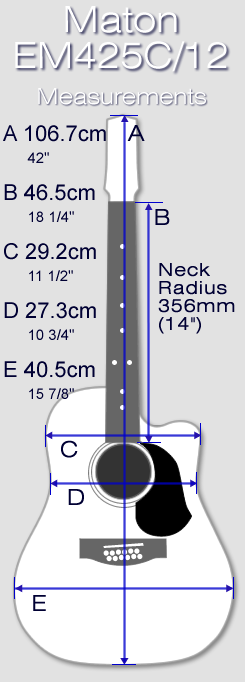
A member of the Maton 400 series, available with and without cutaway. Cutaway 'C' models generally come fitted with AP5 electronics [EM425C/12], whereas non-cutaway versions may be without electronics [M425/12].
| Model Long Name: | 425 Acoustic/Electric Cutaway 12 String |
| Model Short Name: | Maton EM425C/12 |
| Year(s) Sold: | 1989 - 201? (after 2020 rare/impossible to find new) |
| Original RRP* AUD: | 1989 - $1,195 1997 - $1,695 2012 - $1,900 |
| Body Depth: | at C 105mm (4-1/8") at E 120mm (4-3/4") |
| Neck Radius: | 356mm (14") |
| Neck Width @ Nut: | 50mm (1- 31/32") |
| Soundboard: | 'A' Grade - Solid Sitka Spruce |
| Rosette: | Mosaic |
| Outer Binding: | Ivory |
| Inner Binding: | Black/White |
| Back & Sides: | Queensland Walnut (laminated) |
| Neck: | Queensland Maple |
| Fingerboard: | Rosewood |
| Bridge: | Rosewood |
| Frets: | 21 |
| Nut and Saddle | White: Bone (earlier models) Black: Synthetic (glass filled Nylon) |
| Bridge Pins: | ABS plastic |
| Inlays: | Dot Inlays |
| Headstock Veneer: | Victorian Blackwood |
| Pickup: | Earlier AP5 / Much later AP5 Pro |
| Finish: | Satin Clear |
| Pick Guard: | Black |
| Machine Heads: | Grover Chrome Deluxe |
| Case: | Maton Hard Case |
| For more info: | Maton Museum |
Unfortunately the Maton Museum web site is not up to date and reports discontinued instruments as still in production, when they have clearly been replaced by newer models. |
|
Review Ratings:
- Playability - 7 / 10 (required extensive adjustment, better with extra light strings)
- Sound - 9 / 10 Truly delightful
- Build Quality - 7 / 10 Ex-factory action was crap, AP5 is only OK
- Durability & Reliability - 10 / 10 Rock solid - time proven
- Value for Money - 8 /10 solid performer
- Overall Average Score ... 8 / 10
Your comments and contributions are greatly appreciated!
Was this page useful?
Rate This Page:
| Page Ratings so far ... | ||
| Excellent | 8 | |
| Very Good | 0 | |
| Useful | 0 | |
| Not Useful | 0 | |
| TOTAL | 8 | |
Your Comments:
211217 - (Excellent) - Great review thankyou! All of the points you make are so true. I ordered one of these from the factory in 2003. The action was challenging at best. I took it back and they adjusted it beautifully, and now it's one of my favourite guitars in my collection to play.
Editor's Note: Thanks, that has put a smile on my face
211121 - (Excellent) - Really interesting and well worth the read. Thanks.
Editor's Note: No Wuckas.
As an explanatory note for the non-antipodeans reading this:
No Wuckas (pron. wuk'az) = No Worries / Not a Problem / All Good.
Derived from the common slang 'No Wuck'n Furries' (where furries rhymes with worries),
which is a dislexic play on the common, but totally impolite Australian phrase, 'No F**k'n Worries' (often 'No f**k'n worries mate').
... and you are totally right ... we are unapologetically weird.
210712 - (Excellent) - I bought one of these last year. Thought I had found a second hand disaster piece. But after months of work and adjustments. Its great. Difficult to play but I love it all the same.
Editor's Note: That sounds about right.
210712 - (Excellent) - Excellent review. A model of its kind. Well done.
Editor's Note: Appreciated, thanks
.
Incept Date: Wizard - 210117
Last Update: Wizard - 230817

